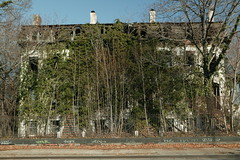The solution to disinvestment is not demolition, it is investment
See "Amid Weeds and Rust, a Ruin Seeks a Second Act," from the New York Times. From the article:
“Those things there? They’ve been there forever,” said Elijah Knox, a resident of the Farragut project who was hurrying across its wind-swept courtyard the other day. “They need to tear them down.”
That is precisely the thinking of the Brooklyn Navy Yard Development Corporation, a nonprofit group that oversees the Navy Yard. The city is asking that the National Guard, which owns the property, give the land to the city so that the corporation can demolish the houses and replace them with a supermarket of roughly 60,000 square feet and a large industrial building. Residents of Farragut and two other public housing projects nearby would be given preference in hiring.
Although preservation groups, including the Landmarks Conservancy and the Historic Districts Council, have publicly attacked that proposal, it has met a mostly warm reception among Farragut residents, who regard the vacant town houses as neglected eyesores.
These buildings were mentioned in a great AMNY article on preservation issues in NYC, "Endangered New York: 10 (more) to save." The photo gallery with the piece has more than 50 photos, and there are links to previous coveraged on "Endangered New York" and many other photo galleries.

Admiral's Row, Brooklyn Navy Yard; plans are under way to build a supermarket here. (amNewYork Photo/ Lane Johnson / December 20, 2007)
I call this kind of process "blaming the building."
Just like "guns don't kill people, people kill people", buildings don't neglect themselves, buildings are neglected by property owners.
The flip side of this is what I call the creation of a noxious use. A property owner with other plans will let a building rot, figuring that residents will see demolition as a solution. But the neighbors don't realize that this merely plays into the hands and plans of the property owner. See for example, "Land owner battles with District preservationists" from the Washington Business Journal.
It is so obvious what the property owner is trying to do. If he was doing it in an area of the city that isn't designated historic, long ago he would have redeveloped the property.
Labels: historic preservation, provision of government services, public assets



0 Comments:
Post a Comment
<< Home